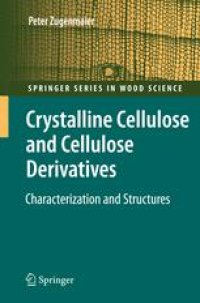
Ebook: Crystalline Cellulose and Derivatives: Characterization and Structures
- Tags: Agriculture, Forestry, Plant Sciences
- Series: Springer Series in Wood Science
- Year: 2008
- Publisher: Springer-Verlag Berlin Heidelberg
- Edition: 1
- Language: English
- pdf
This book constitutes a valuable, concise and up-to-date guide for the materials and life science community interested in cellulose and related materials. Reliable crystal structures of all cellulose polymorphs and cellulose derivatives determined are critically reviewed and discussed. Models are represented in graphs together with a collection of geometrical data as well as the atomic coordinates for further use. The background for fiber diffraction, computer-aided modeling and spectroscopic investigations is briefly introduced and also included are the necessary molecular data from oligosaccharides as a basis for structure evaluations. X-ray diffraction patterns and spectroscopic diagrams are presented as references to characterize cellulosic materials and to serve as fingerprint tools for the exploration of unknown specimens of cell walls and of industrially processed films and fibers as well as solid-state materials.
Cellulose as an abundant renewable material has stimulated basic and applied research throughout the years, as addressed in a historical review, and has inspired significant progress in polymer science. In recent years cellulose has gained renewed importance as a raw material and still possesses high potential for future applications. Academia and industry may equally profit from this comprehensive survey.
This book constitutes a valuable, concise and up-to-date guide for the materials and life science community interested in cellulose and related materials. Reliable crystal structures of all cellulose polymorphs and cellulose derivatives determined are critically reviewed and discussed. Models are represented in graphs together with a collection of geometrical data as well as the atomic coordinates for further use. The background for fiber diffraction, computer-aided modeling and spectroscopic investigations is briefly introduced and also included are the necessary molecular data from oligosaccharides as a basis for structure evaluations. X-ray diffraction patterns and spectroscopic diagrams are presented as references to characterize cellulosic materials and to serve as fingerprint tools for the exploration of unknown specimens of cell walls and of industrially processed films and fibers as well as solid-state materials.
Cellulose as an abundant renewable material has stimulated basic and applied research throughout the years, as addressed in a historical review, and has inspired significant progress in polymer science. In recent years cellulose has gained renewed importance as a raw material and still possesses high potential for future applications. Academia and industry may equally profit from this comprehensive survey.
This book constitutes a valuable, concise and up-to-date guide for the materials and life science community interested in cellulose and related materials. Reliable crystal structures of all cellulose polymorphs and cellulose derivatives determined are critically reviewed and discussed. Models are represented in graphs together with a collection of geometrical data as well as the atomic coordinates for further use. The background for fiber diffraction, computer-aided modeling and spectroscopic investigations is briefly introduced and also included are the necessary molecular data from oligosaccharides as a basis for structure evaluations. X-ray diffraction patterns and spectroscopic diagrams are presented as references to characterize cellulosic materials and to serve as fingerprint tools for the exploration of unknown specimens of cell walls and of industrially processed films and fibers as well as solid-state materials.
Cellulose as an abundant renewable material has stimulated basic and applied research throughout the years, as addressed in a historical review, and has inspired significant progress in polymer science. In recent years cellulose has gained renewed importance as a raw material and still possesses high potential for future applications. Academia and industry may equally profit from this comprehensive survey.
Content:
Front Matter....Pages i-x
Introduction....Pages 1-6
History of Cellulose Research....Pages 7-51
Background....Pages 53-75
Model Compounds....Pages 77-99
Cellulose....Pages 101-174
Cellulose Derivatives....Pages 175-206
Morphology....Pages 207-221
Back Matter....Pages 223-285
This book constitutes a valuable, concise and up-to-date guide for the materials and life science community interested in cellulose and related materials. Reliable crystal structures of all cellulose polymorphs and cellulose derivatives determined are critically reviewed and discussed. Models are represented in graphs together with a collection of geometrical data as well as the atomic coordinates for further use. The background for fiber diffraction, computer-aided modeling and spectroscopic investigations is briefly introduced and also included are the necessary molecular data from oligosaccharides as a basis for structure evaluations. X-ray diffraction patterns and spectroscopic diagrams are presented as references to characterize cellulosic materials and to serve as fingerprint tools for the exploration of unknown specimens of cell walls and of industrially processed films and fibers as well as solid-state materials.
Cellulose as an abundant renewable material has stimulated basic and applied research throughout the years, as addressed in a historical review, and has inspired significant progress in polymer science. In recent years cellulose has gained renewed importance as a raw material and still possesses high potential for future applications. Academia and industry may equally profit from this comprehensive survey.
Content:
Front Matter....Pages i-x
Introduction....Pages 1-6
History of Cellulose Research....Pages 7-51
Background....Pages 53-75
Model Compounds....Pages 77-99
Cellulose....Pages 101-174
Cellulose Derivatives....Pages 175-206
Morphology....Pages 207-221
Back Matter....Pages 223-285
....